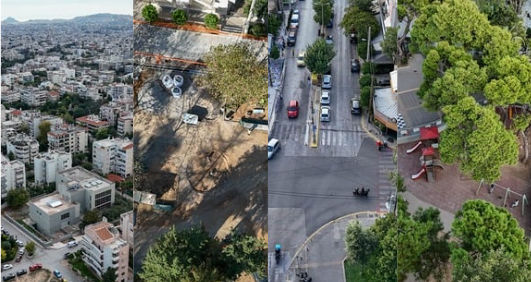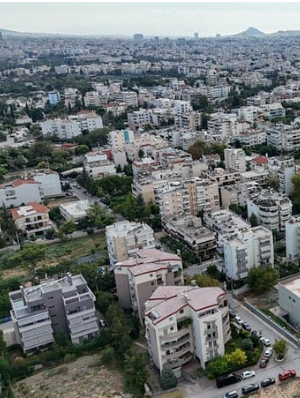
Exploring the concept of Compact Cities: insights from the Ex-Ante Assessment expert
To help potential applicants better understand the topic, we interviewed Ivana Katurić, the external expert behind the Ex-Ante Assessment (EAA), the analysis that underpins this Partnership by clarifying its scope and providing focus in preparation for the upcoming call.
Dive into the full article to learn more about her insights on the topic of the new Partnership.

Ivana Katurić is an Assistant Professor of Sustainable Urban Development at the University of Rijeka (UNIRI) and the Director of Urbanex, a European-level think tank, consultancy, and research organisation focused on sustainable development.
In this article, she shares her perspectives on the concept of compact cities, why it remains highly relevant today, and how the Urban Agenda’s multilevel governance approach can help tackle the complexities of compact urban planning.
You describe compact cities as a powerful counter to diffuse urbanisation —but also full of trade-offs. What’s the biggest misconception about compact urban development that you think this report (EAA) corrects?
One of the most significant misconceptions in urban development, especially regarding compact cities, is the belief that a single solution can address all contexts, or that the issues involved are simply black and white. This report challenges that notion by drawing on research that frames sustainable urbanisation as a complex, multidimensional process that requires balancing the three pillars of sustainability: economic, environmental, and social. As a result, discussions about trade-offs are inevitable, and the emphasis should be on designing comprehensive urban policies that thoughtfully navigate these competing priorities.
A common perception is that the main trade-off of compact urbanisation is higher housing prices, while the primary driver of dispersed urbanisation is the availability of cheaper housing on the urban periphery. However, some studies suggest this relationship is not always straightforward; the way increased land value is managed and captured can play an even more significant role in housing affordability. Issues such as the housing crisis, mobility poverty, and energy poverty are all intertwined with these dynamics.
The sustainability of urban development is far from clear-cut. Often, there are trade-offs between different dimensions of sustainability. This is why the format of the Urban Agenda for the EU partnership is important, to highlight the multifaceted dimensions of sustainable urban development contributing to better regulation, better funding and better knowledge.
Small and medium-sized cities are highlighted as key players—but also as under-resourced. What practical steps can we take to ensure they’re not left behind in shaping Europe’s urban future?
Large cities are often more visible and tend to have greater capacities to participate in multi-level policy discussions. However, sustainable urbanisation is equally relevant to small and medium-sized cities. We want to understand the issues and challenges these cities face both when they are part of a functional urban area (FUA) and when they are not. Their urbanisation drivers can differ significantly depending on their position, and their coping mechanisms should be distinct. This is why it is of utmost importance to include them in the Urban Agenda for the EU Partnership.

The issues of sustainable urbanisation do not recognise administrative boundaries. In the context of FUAs, small and medium-sized cities are affected by the transformations of the central city. Often, affordable living on the periphery is linked with car-dependent territories, which shapes the realities of these cities. This dynamic creates specific challenges related to land use, housing, mobility, and infrastructure that differ from those faced by large urban centres or standalone small cities.
Small and medium-sized cities differ in their unique needs, goals, and trade-offs. They are also frequently underrepresented in policy discussions and excluded from initiatives due to limited administrative and financial resources. To address these differences and challenges, compact cities discussion must be sensitive to the diversity of urban contexts, ensuring all territories are included in multi-level cooperation. Therefore, recommendations for regulations and financial support should explicitly recognise diversity, supporting small and medium-sized cities in working on the set of relevant policy interventions.
With many competing urban models—15-minute cities, post-growth, regenerative cities—why do you think compact urbanisation remains such a unifying and timely approach for EU cooperation right now?

Our role is not to uncritically adopt fashionable policy concepts, but - as Evers* (2024) suggests - to actively interrogate their implications and offer alternatives when necessary. Compact urbanisation continues the European tradition of sustainable urban development, emphasising the importance of understanding the path dependencies of planning systems and welfare models in designing comprehensive urban policies. The Urban Agenda for the EU Partnership on Compact Cities is not simply a debate about urban form, but about the practical dimensions through which sustainable urban development can be implemented.
At the EU level, some of the important processes are happening such as the Soil Monitoring Law and the Nature Restoration Law, which set new expectations for urban areas, to monitor soil sealing, prevent further loss of green spaces, and increase tree cover. Compact urbanisation provides a strong foundation by focusing on containment, densification, and regeneration, helping cities operate within spatial and ecological limits.
However, achieving social balance is crucial and often overlooked in discussions about urban form. Therefore, the Compact Cities Partnership should focus on how the diversity of EU cities experience these issues and explore varied solutions looking at the critical topics such as affordable housing, energy and mobility poverty. This approach builds on previous successful Urban Agenda for the EU partnerships, such as those on Sustainable Use of Land and Nature-Based Solutions (SUL-NBS), and Housing, as well as existing literature, and, most importantly, on the co-creation of knowledge to implement effective policies within a realistic timeframe.
Also, the Urban Agenda for the EU provides an excellent framework to start the long-term activation process. This is evident from previous partnerships—such as the Partnership on Sustainable Land Use and Nature Based Solurtions mentioned above —and the impact they have had on legislation and funding schemes at various levels
Get ready for the upcoming call on Compact Cities
The Call for Partners on Compact Cities will open on 27 August. Until then, interested stakeholders are encouraged to review the Ex-Ante Assessment to gain a deeper understanding of the thematic scope and how potential partners can contribute to the Partnership.
Additionally, an online applicant seminar will be held on 3 September, providing detailed information about the application process and what to expect from a Thematic Partnership within the Urban Agenda for the EU.
*Evers, D., Katurić, I., & van der Wouden, R. (2024). Urbanisation in Europe: Past developments and pathways to a sustainable future